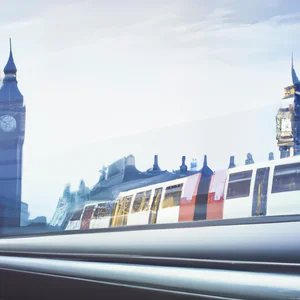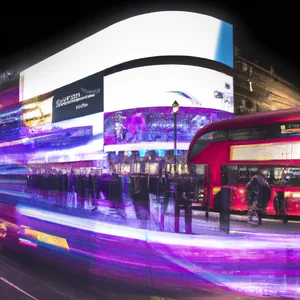Book your experience
Oyster Card or Contactless?
Oyster Card or Contactless: which of the two is the right choice for getting around London? Well, well, let’s talk about it for a moment.
So, when it comes to traveling to the British capital, you basically have two ways to go. On the one hand there is the Oyster Card, which, for those who don’t know, is the card you use to take the tube, buses and everything else. In short, it’s like a passport for public transport. On the other hand, there’s contactless payment, which simply means you can use your credit card or phone to pay without having to get out your Oyster. Convenient, right?
Now, I’ve tried both options. The first time I went to London, I had no idea what the Oyster Card was, and ended up paying a lot of money via contactless. Sure, it was easy, but I noticed that at the end of the day, the costs add up. It’s like that moment when you think you’ve only spent a couple of euros, but then you check and realize you’ve emptied your wallet. A real blow to the heart!
On the other hand, the Oyster Card has much more advantageous rates, especially if you plan to use public transport more than once. Of course, you have to charge it first and remember to tap it when entering and exiting, but it’s really worth it, in my opinion. And then, there’s something satisfying about seeing it flow through the reader, almost like when you win a little battle against the system.
But, well, I don’t want to say that one is absolutely better than the other. It really depends on how you roll. If you’re one of those who only takes a couple of trips, then contactless can be great. But if, like me, you like to wander around London left and right, well, the Oyster could prove to be a real bargain.
In conclusion, I think the right choice depends on your travel style. Maybe you could even try both options and see which one makes you feel better. In the end, the important thing is to have fun and discover this wonderful city. And who knows? Maybe you come across a fabulous pub to spend the evening in!
Oyster Card: the ideal companion for travellers
I still remember my first trip to London, when I discovered the magic of the Oyster Card. As I was about to get on the Tube at King’s Cross stop, I felt like a true Londoner. With a simple gesture, I held my Oyster Card close to the reader and, in an instant, I was immersed in the pulsating streets of Camden Town. This little piece of plastic isn’t just a payment method; it’s a passport to adventure.
A practical way to explore the city
The Oyster Card is one of the most convenient options for getting around London. It can be used on the tube, buses, trams, DLR, London Overground and even some national rail lines. Currently, a prepaid Oyster Card offers significantly lower fares than traditional paper tickets, making your travel more economical and convenient. According to the official Transport for London (TfL) website, by using the Oyster Card, you can save up to 50% on travel costs compared to purchasing single tickets.
Insider tip: “pay as you go” is key
A little-known aspect is that you can also use the Oyster Card for the “pay as you go” system. This allows you to add credit to your card and travel without having to pre-purchase specific tickets. An insider trick is to check your card balance via the TfL app, which allows you to plan your journeys more efficiently and without surprises.
A profound cultural impact
The Oyster Card has revolutionized the way Londoners and tourists get around the capital. Introduced in 2003, it marked a significant change in the culture of public transport in London, making travel more accessible and less stressful. Today, it has become a symbol of British efficiency and innovation, reflecting a commitment to modernizing infrastructure.
Sustainability in transport
Using the Oyster Card is not only an economic choice, but also a responsible choice. Every journey you take with Oyster rather than a paper ticket helps reduce your environmental impact. London is making great strides towards sustainability, and using your Oyster Card is an easy way to participate in this effort.
An authentic experience
For a truly authentic experience, I recommend using your Oyster Card to visit Borough Market. Not only will you be able to enjoy delicious local dishes, but you will also have the opportunity to interact with vendors and discover London’s food history.
Myths to dispel
A common misconception is that the Oyster Card is only for tourists. In fact, it is widely used by Londoners, which shows how integrated it is into everyday life in the city. Don’t let its reputation fool you: the Oyster is an essential travel companion for anyone wanting to immerse themselves in London culture.
A final reflection
As you explore London with your Oyster Card, ask yourself: What is your favorite corner of the city? Every trip is an opportunity to discover something new, and the Oyster Card is your perfect ally on this adventure. With a simple gesture, the world of London opens up before you.
Contactless: the convenience of contactless payment
The elegance of a simple gesture
I still remember my first trip to London, when, while walking along the Thames, I realized how quick and easy it was to get around the city. The key to this fluidity? Contactless technology. Based on a simple gesture, contactless payment has revolutionized the way travelers like me explore the British capital. No more endless queues to buy a ticket, but just a quick tap on the validator and off you go! This system made every move a stress-free experience, allowing you to fully enjoy the beauty of London.
Practical and up-to-date information
Today, Contactless is widely accepted not only on public transport, but also in many shops, restaurants and tourist attractions. To use this payment method, all you need is a Contactless-enabled debit or credit card. According to Transport for London (TfL), Contactless payments work just like the Oyster Card, but without the need for a specific pass. Furthermore, there are no additional costs: the price of the journey will be the same as you would have paid with Oyster.
An insider tip
Here’s a little-known trick: if you have a foreign contactless card, remember to pay in sterling. Some terminals offer the option of currency conversion, but this may incur additional costs. Staying in your own currency will allow you to save.
Cultural and historical impact
The Contactless system is not only a technological innovation, but also represents a cultural change. Its spread is emblematic of a London that embraces modernity, making access to public transport more inclusive and accessible. In an increasingly digitalized world, the shift from traditional paper tickets to contactless solutions reflects the growing demand for efficiency and convenience from citizens and tourists.
Sustainability and responsible practices
Adopting Contactless payment is also a step towards sustainable tourism practices. By reducing the use of paper tickets, we help reduce waste and support a cleaner environment. This choice not only simplifies travel, but also has a positive impact on the city’s ecosystem.
An activity worth trying
During your stay in London, try using Contactless to explore local markets, such as Borough Market. Here, you can enjoy typical British cuisine, and with a simple tap you can pay for delicatessen without having to search for coins or wait in long queues.
Myths to dispel
A common misconception about the Contactless system is that it is less secure than traditional payment methods. In fact, Contactless uses the same security technology as credit cards, with advanced encryption to protect your data.
A final reflection
Next time you are in London, ask yourself: how much time could you save by adopting the Contactless system? This small choice could free you from long waits and allow you to discover unexplored corners of the capital. Technology, after all, is here to make your travel experience not only more comfortable, but also richer. And you, are you ready to touch the future?
Saving on transport: Oyster vs. Contactless
A personal anecdote
I remember my first trip to London, when, after a long day exploring the markets of Camden, I decided to head back to the hotel. With the sun setting behind the historic buildings, I stood outside King’s Cross tube station, unsure of the best way to pay for my fare. It was then that a kind Londoner advised me to opt for the Oyster Card, a gesture that proved to be my passport to saving time and money.
Practical and up-to-date information
The Oyster Card and Contactless payment are two of the most popular options for getting around London. While the Oyster Card is a prepaid card that offers discounted rates compared to paper tickets, Contactless payment allows you to use credit, debit cards or devices enabled for contactless payment. Both methods offer significant savings, but there are some differences to consider:
Oyster Card:
- Lower fares than single tickets.
- Rechargeable at stations, shops and online.
- Possibility of using the card also for buses, trams and ferries.
Contactless:
- No need to purchase a physical card; you can simply use your bank card.
- Similar rates to Oyster, but without the need to top up.
- Convenience of fast payment.
According to Transport for London (TfL), both methods can lead to savings of up to 50% on transport costs compared to single tickets.
An insider tip
A little-known trick is that if you have an Oyster Card, you can register it online to receive a £5 credit as a bonus for your first top-up. Also, if you plan to travel a lot in a single day, check your maximum daily spending limit, which can save you even more. This is especially useful for tourists who want to explore without worrying about excessive expenses.
Cultural and historical impact
The introduction of the Oyster Card in 2003 marked a turning point in the way Londoners and visitors get around the capital. This system has made public transportation more accessible and encouraged greater use of public transportation options, reducing congestion and pollution. London has always had a culture of mobility and innovation, and the Oyster Card has become a symbol of this spirit.
Sustainable tourism practices
Choosing to use the Oyster Card or Contactless payment is not only convenient, but it is also a responsible choice. Using public transport reduces the environmental impact compared to using private vehicles, contributing to a more sustainable London. Additionally, many metro stations now offer information on how to travel more eco-friendly.
An activity worth trying
For an authentic experience, grab your Oyster Card and head to Borough Market. Not only can you save on transport, but you’ll also be able to savor some of London’s best culinary offerings as you explore food stalls from around the world. It’s a perfect way to immerse yourself in the local culture.
Myths and misconceptions
One of the most common myths is that the Oyster Card is the only way to save on transport in London. In reality, the Contactless system offers the same savings, but with the convenience of not having to manage a physical card. Additionally, many people mistakenly believe that using the Oyster Card takes time to top up; in reality, top-ups can be done quickly at any station.
Final reflection
Next time you’re in London, which payment method will you choose to explore this vibrant city? The convenience of the Oyster Card or the convenience of Contactless? Both options offer unique benefits, but what matters most is the experience of discovering London, one ride at a time. What’s your preference?
How the fare system works in London
A personal experience in the tariff maze
I still remember my first time in London, when, armed with a map and a good dose of enthusiasm, I found myself faced with the complexity of the public transport fare system. While I was trying to decipher the fares for the metro areas, a kind local smiled at me and said: “Don’t worry, the Oyster Card is your best friend here.” That sentence marked the beginning of a new adventure and opened the doors for me to a different way of exploring the British capital.
The tariff system: a precise mechanism
In London, the pricing system is structured according to zones. The city is divided into different areas, starting from zone 1, which includes the center, up to zone 9, which embraces the suburbs. Fares vary depending on the area you travel to and the mode of transport you use, which can include tube, bus, tram, London Overground and suburban trains. By using an Oyster Card, the cost of your journey is automatically calculated, ensuring lower fares than paper tickets. For example, a single tube journey from zone 1 to zone 2 costs £2.40 on Oyster, while a paper ticket costs £4.90.
An insider tip
Here’s a little-known tip: if you travel frequently in a single day, consider the “Daily Cap” option. This means that once you reach a certain amount spent in a day, you will no longer be charged for further trips. It’s a smart way to save money, especially if you plan to visit several attractions.
The cultural impact of tariffs
London’s fare system isn’t just about numbers; it also reflects the culture of the city. The diversity of fares is a way to make public transport accessible to all, thus promoting mobility and meetings between different communities. It’s not uncommon to see a street performer entertaining passengers on the subway, turning a simple ride into a cultural experience.
Responsible tourism practices
In an age where sustainability is key, using London’s public transport is a responsible choice. Every time you choose to travel by subway or bus instead of a taxi, you help reduce your environmental impact. London is investing in low-emission vehicles and initiatives to improve air quality, making public transport increasingly eco-friendly.
Soak up the atmosphere
Imagine getting off at the Piccadilly Circus stop, surrounded by bright billboards while the scent of street food mixes with the crisp air. With your Oyster Card in hand, you’re ready to explore not only the iconic sights, but also the hidden alleyways of this vibrant city.
Recommended activity
For a unique experience, try visiting the market Borough, a short walk from London Bridge tube station. Here you can savor local and international culinary delights, all while using public transport to get from one point of the city to another.
Myths to dispel
A common misconception is that the Oyster Card is only for tourists. In fact, it’s widely used by Londoners too, proving just how convenient it is. Some people think that paper tickets are always a better option, but in many cases, you can save significantly with the Oyster Card.
A final reflection
Next time you find yourself in London, ask yourself: how might your travel experience change if you fully embraced the public transport system? Discovering the city through the lens of the Oyster Card can reveal unexpected corners and untold stories. We invite you to explore, get lost and find your own unique path through London’s complex twists and turns.
A little-known option: the weekly Travelcard
A memory that resonates
I remember my first trip to London: the vibrant streets, the smell of fish and chips wafting through the air and the unmistakable sound of “Mind the gap” ringing out at every tube stop. Of all the wonders the city has to offer, one of the most valuable tools for exploring it has been the weekly Travelcard. This option, often overlooked by tourists, proved to be a smart choice, allowing me to travel without limits between the different neighborhoods of the capital.
The weekly Travelcard: a strategic option
The weekly Travelcard gives you unlimited travel across London on the tube, buses and trains, and is available for zones 1-2, 1-3 and 1-4. But it’s not just about convenience: it’s also an extremely convenient option. For example, from 2023, the price for a weekly Travelcard for zones 1-2 is around £40, which can be a bargain if you plan visits to multiple attractions in different parts of the city. According to Transport for London, this type of ticket is ideal for those who want to immerse themselves in London life without worrying about excessive transport costs.
An insider tip
Here’s a little-known tip: if you buy your weekly Travelcard online or at a point of sale, you can also get a discount compared to the purchase price at the station. Don’t forget to bring a passport photo with you, as some retailers may require this to issue the Travelcard.
A connection to history
The Travelcard has deep roots in London’s public transport system, dating back to the 1980s. This tool reflects the evolution of mobility in the capital, responding to the needs of an ever-expanding city. Through its use, travelers not only explore London, but participate in a tradition that celebrates discovery and adventure.
Sustainability and responsibility
Opting for a weekly Travelcard also contributes to sustainable tourism practices. By using public transport, you reduce your environmental impact, an increasingly important choice in a city that is facing environmental challenges. Furthermore, London’s public transport is constantly striving to improve its sustainability through the electrification of buses and the strengthening of cycling infrastructure.
An experience worth trying
During your stay, I recommend visiting Borough Market, one of the oldest food markets in London. With the weekly Travelcard, you can easily reach this gastronomic jewel and savor local delicacies, from artisanal cheese to ethnic dishes. Don’t forget to explore the surrounding streets too, full of unique cafes and shops.
Myths to dispel
A common misconception is that the weekly Travelcard is only for long-term stayers. In fact, it is also a great choice for tourists who want to visit multiple attractions in a week. Unlike the Oyster Card, which is more suitable for short trips, the Travelcard offers a significant advantage for those looking to explore the city more widely.
Final reflection
In conclusion, the weekly Travelcard is not just a means of getting around London: it is a key to discovering the city in a profound and authentic way. We encourage you to consider this option on your next trip. Which corners of London do you dream of exploring without limits?
Sustainability in transport: responsible choices in London
Imagine yourself in one of the most dynamic metropolises in the world, London, as you move between its iconic red double-decker buses and elegant subways. During your last trip, you decided to use the Oyster Card and, walking through the Borough markets and lively Soho, you realized that every trip not only leads you to discover new wonders, but also contributes to a more sustainable future .
A transport system designed for the environment
London has made great strides in making its transport system greener. In 2021, 60% of subway trips were already made with electricity from renewable sources. Using the Oyster Card or contactless payment, travelers can access a system that promotes not only convenience, but also sustainability. According to Transport for London (TfL), using these payment methods has reduced the need for single-use plastic, contributing to a cleaner environment.
An insider tip: explore the cycling network
If you want to experience London in an even more sustainable way, in addition to public transport, consider the option of renting a bicycle. The ever-expanding network of cycle paths offers a unique way to explore the city whilst reducing your environmental impact. Don’t forget to download the Santander Cycles app to have access to rental bikes across the city!
The culture of sustainability
The cultural impact of these sustainable choices is profound. London has always been a crossroads of innovation and diversity, and its growing focus on sustainability is a reflection of the values of a generation that cares about the future of the planet. Initiatives such as the “Ultra Low Emission Zone” (ULEZ) program are transforming the city, making it more breathable and liveable for everyone.
The importance of conscious choices
Many tourists may think that using an Oyster Card is just a way to save on transport. However, it is much more: it is a responsible choice that contributes to a more sustainable transport system. It is a decision that reflects a commitment to ethical and conscious tourism.
An unmissable activity
To fully immerse yourself in London’s sustainable culture, take a guided bike tour through the city’s royal parks, such as Hyde Park and Kensington Gardens. You’ll discover not only London’s natural beauty, but also stories of ongoing green initiatives. Don’t forget to bring a reusable water bottle to stay hydrated during the tour!
Final reflections
Next time you wander the streets of London, ask yourself: how can I contribute to a more sustainable city? Every choice matters and every journey can be an opportunity to make a difference. The beauty of London lies not only in its monuments, but also in its ability to evolve and respond to modern challenges. Choosing to travel responsibly is a step towards a better future for everyone.
History of the Oyster Card: an innovation in transport
I still remember my first trip to London, when, with the tube map rolled up in my pocket and a bit of tourist anxiety, I approached the counter at Paddington station to buy my Oyster Card. The emotion in holding that small blue and green plastic card in my hands was palpable. Since then, my London adventure has become much easier and, above all, cheaper. This tool, which today seems an essential element for every traveler, has a fascinating and innovative history.
A little history
Introduced in 2003, the Oyster Card has revolutionized the way Londoners and tourists get around the capital. Before the arrival of this smart card, travelers were forced to use paper tickets, which were often expensive and impractical. The Oyster Card has changed the rules of the game, allowing quick and convenient access to London’s public transport, from tubes to buses and overground trains.
As well as its convenience, the Oyster Card has also had a significant impact on fares. Thanks to a usage-based pricing system, users can save significantly compared to single tickets. According to Transport for London, travelers can save up to 50% on fares compared to purchasing paper tickets.
An insider tip
Here’s a little-known tip: many tourists don’t know that they can return their Oyster Card at the end of their trip and receive their £5 deposit back, plus any remaining funds. This is a great way to save further and contribute to more responsible tourism.
The cultural impact
The Oyster Card has become a symbol of the modernity and efficiency of London transport. It has not only facilitated the transport of millions of people, but has also contributed to greater sustainability by encouraging the use of public transport over the private car. Over the years, the Oyster Card has seen the introduction of new technologies, such as contactless payment, which has further simplified access to public transport.
An experience not to be missed
During your visit, don’t miss the opportunity to explore London using the Oyster Card. I recommend traveling to the Camden district, famous for its markets and lively music scene. There, you can enjoy international dishes and browse quirky shops, all without worrying about how to get there.
Myths to dispel
A common misconception is that the Oyster Card is only for London residents. In fact, it is a perfect option for tourists too, who can easily purchase and recharge it at any metro station.
Final reflection
The Oyster Card is not just a means of traveling in London; it is an experience that combines practicality and innovation. We invite you to consider how a simple card can transform your adventure in the British capital. Have you ever wondered how much the way we move affects our travel experience?
Authentic experiences: travel like a Londoner
Imagine yourself on a warm summer morning in London, the sun filters through the skyscrapers and the air is filled with the scent of fresh coffee from a small local café. Right next to your hotel, a group of Londoners stream towards the tube, each with their own Oyster Card ready to be used. You join them, and in that moment, you are no longer a mere tourist, but a traveler who embraces the essence of London life.
The Oyster Card: a passport to authenticity
The Oyster Card is not just a means of getting around; it is a symbol of how Londoners deal with the city. With this card, you can access not only the subway, but also buses and ferries, making travel smooth and easy. Plus, discounts on transport fares can make a difference to your budget, allowing you to save as you explore every corner of the capital.
If you want an authentic experience, try using your Oyster Card to visit historic markets like Borough Market or Camden Market, where the true soul of London is revealed through food, art and culture.
Insider tip: Londoners’ secret
A little-known tip is to pay attention to peak times. Londoners know how to avoid overcrowded trains, and you should do the same. If you can, schedule your trips for early morning or late afternoon. Also, try exploring the roads and streets less traveled; you’ll often find hidden corners and local gems that tourists overlook.
The cultural fabric of London
The Oyster Card has changed the way Londoners get around, contributing to a more sustainable and connected transport system. It is an example of how technology can simplify everyday life, and has become an integral part of urban culture. Since it was introduced, the Oyster Card has reduced the number of paper tickets, contributing to a greener London.
An activity worth trying
While you’re moving around with your Oyster Card, don’t miss the opportunity to take a ride on the historic London Eye. Tickets can be purchased in advance using your Oyster Card, allowing you to skip the queue and enjoy stunning views of the city from above. It’s a perfect way to end a day of exploration.
Common misconceptions
A common misconception is that the Oyster Card is only convenient for residents. In fact, even tourists can benefit from it! Also, don’t forget to register it online: in case of loss, you can recover the remaining balance, an advantage that many travelers ignore.
In conclusion, using the Oyster Card is not just a way to travel, but an opportunity to immerse yourself in a vibrant and dynamic culture. Next time you are in London, ask yourself: are you ready to experience the city like a real Londoner?
Rates for children: what to know before leaving
When I visited London with my family last year, one of the main concerns was how to manage transportation for our little travellers. I remember the scene vividly: we were queuing to load our Oyster Cards, with the children jumping around eagerly, and I realized that the topic of child fares is something vital to know about.
Practical and up-to-date information
In London, children under 11 travel for free on public transport, as long as they are accompanied by a paying adult. This means that if you have two children, you can save quite a few pounds! Furthermore, children aged between 11 and 15 can get a Young Visitor Discount with the Oyster Card, which offers reduced fares on both public transport and some attractions. Don’t forget to check the official London Transport website for the most up-to-date information.
An insider tip
Here’s an unconventional tip: if you’re planning on visiting a lot of attractions, consider combining your Oyster Card with the London Pass. This way, you can not only save on transportation, but also get discounted admissions to many popular attractions. It’s a fantastic way to optimize your travel budget and make the experience smoother!
A touch of history
Child fares reflect a very important cultural aspect in London: the idea of making the city accessible to all families. This policy was introduced in 2007 and has made public transport more inclusive, encouraging families to explore the capital without worrying too much about costs.
Sustainability in transport
Opting for public transport is a responsible and sustainable choice. Every tube or bus journey reduces your environmental impact, and with children traveling for free, you can teach them the importance of traveling in an eco-friendly way from an early age.
Soak up the atmosphere
Imagine getting on a double-decker bus with your children, leaning out the window to admire London’s iconic landmarks. Every trip becomes an adventure! And don’t forget to stop at a local park, like Hyde Park, where kids can run and play after a long day of exploring.
Address common myths
A common misconception is that public transportation is complicated or expensive for families. In fact, with a little planning, you can make your trip much cheaper and easier. Remember that Oyster Card and Contactless offer reduced fares, and with children traveling free or at discounted prices, there’s no reason to avoid public transport.
Concluding
Ultimately, taking advantage of child fares in London can transform your trip. Not only will you save money, but you will also have the opportunity to share unforgettable experiences with your family. So, next time you’re getting ready to go, ask yourself: How can I make my trip to London even more special for my kids?
Insider tip: avoid peaks in attendance
A journey through London public transport
During one of my visits to London, I vividly remember one Monday morning. Intending to explore the bustling Borough Market, I found myself aboard a crowded Tube train, packed with commuters heading to work. The frenzy of that moment made me realize how crucial it is to plan your movements in such a vibrant and, at times, oppressive metropolis. Avoiding peak crowds is not just an insider tip, but a true art that can transform your travel experience.
Practical information
London is known for its efficient public transport system, but peak traffic can make even the simplest commute a nightmare. Rush hours are concentrated between 7.30am and 9.30am and between 5pm and 7pm, when Londoners crowd into public transport to get to work or home. To avoid finding yourself in a crowd of people, I advise you to plan your trips outside these time slots. Sources such as TfL (Transport for London) offer real-time updates and information on waiting times, making planning easier.
Unconventional advice
A trick that few people know is to use the less crowded Tube stops. For example, instead of getting off at central stops like Oxford Circus, consider getting off at stops like Tottenham Court Road or Leicester Square. Although it requires a short walk, it will allow you to enjoy a quieter atmosphere and admire the city without the pressure of crowds.
Cultural and historical impact
London is a city that has embraced public transport since 1829, when the first horse-drawn coach line was introduced. Today, the transportation system is a reflection of the city’s cultural and historical diversity. Avoiding peak crowds not only improves your experience, but also helps maintain a more sustainable and less stressful flow for everyone.
Sustainable tourism practices
Opting for off-peak travel not only improves your trip, but is also a more sustainable choice. By reducing your presence during rush hour, you help reduce the environmental impact of public transport, contributing to a cleaner and more liveable London.
An experience worth trying
For an authentic experience, consider visiting Borough Market during the week, preferably on a weekday, when the crowds are more manageable. You will be able to enjoy delicious local dishes and discover fresh products without the pressure of crowded weekends.
Common myths
A common misconception is that public transport is always crowded. In fact, traveling in London can be a pleasant and peaceful experience if you avoid rush hour. It is not uncommon to find semi-empty carriages during quiet hours, turning your journey into a moment of relaxation.
Final reflection
Have you ever thought about how much your travel experience can change simply by changing the time you choose to travel? London has so much to offer, and planning your travels wisely can open the door to unexpected discoveries and unforgettable moments. What’s your favorite way to explore a new city?

 Architecture and Design
Architecture and Design Cities and Regions
Cities and Regions Culture and History
Culture and History Events and Festivals
Events and Festivals Fashion and Shopping
Fashion and Shopping Food and Wine
Food and Wine Nature and Adventure
Nature and Adventure Unique Experiences
Unique Experiences



























